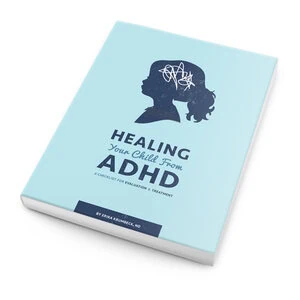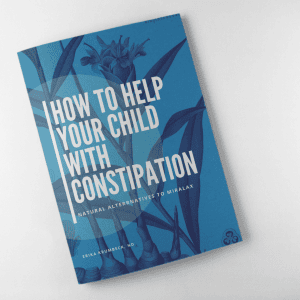The fine line between Elimination Diets and Eating Disorders
Are you a healthcare provider? Read our article on Elimination Diets and Eating Disorders on Naturopathic Pediatrics PRO.
As a pediatric naturopathic doctor I have over ten years of experience using therapeutic elimination diets in children. I have seen many cases of dramatic reversal of chronic disease or behavior concerns.
That said, in the last few years I have found myself increasingly hesitant to recommend restrictive diets, especially as elimination diets have exploded in popularity in the last few years. Food sensitivity tests can now be purchased online and social media is enamored with all sorts of elimination diets. Although they can be a powerful tool for healing, there’s certainly some nuance that we collectively seem to be missing.
In this article, I’ll outline the difference between elimination diets, orthorexia and other eating disorders (and the overlapping features), the dangers of elimination diets, and when they are and aren’t appropriate. I’ll also discuss how to provide guidance on elimination diets with families while maintaining a positive relationship with food.
Elimination Diets vs. Orthorexia vs. Other Eating Disorders
Elimination diets are eating plans that remove foods or food groups believed to cause an adverse reaction, followed by a systematic reintroduction of that food or food group. By removing foods for a period of time and then reintroducing them during a “challenge” period, we begin to understand which foods may be causing or exacerbating symptoms.
Orthorexia is a term used to describe an unhealthy hyper-fixation on eating healthy or “clean” foods. Foods considered “healthy” vary from person to person. The obsession with eating healthy can become restrictive and lead to malnutrition, increased stress, anxiety, and social isolation. Anorexia nervosa is an eating disorder characterized by weight loss, challenges maintaining an appropriate body weight, and in many, a distorted body image.
The overlap between elimination diets and individuals struggling with anorexia or other eating disorders like bulimia and binge eating disorder is hard to quantify. However, a prominent characteristic of all eating disorders is a general restriction of the number of calories and types of food eaten. Since elimination diets restrict types of food and caloric restriction is often a byproduct, it’s easy to see how elimination diets could quickly tip into unhealthy territory.
The Downsides of Elimination Diets
The downsides of elimination diets are considerable, especially in the context of children. Elimination diets are inherently restrictive and can lead to macro and micro nutrient deficiencies, as well as tip into unhealthy, eating disordered territory.
Some elimination diets, such as a gluten-free diet for people with Celiac, do not include the reintroduction period. Many of the other popular elimination diets like low FODMAP, SCD, dairy-free, grain-free, nightshade-free, etc. are designed to have a re-introductory period to assess how the eliminated foods impact the individual. However, the re-introduction phase seems to be a forgotten piece of these therapeutic diets and people often continue chronically eliminating foods.
Since elimination diets remove specific foods or food groups, it’s common to refer to foods as “good” or “bad”. It can be challenging for children and their parents to grasp that these foods aren’t inherently good or bad, rather, they aren’t working for their child’s body at this point in time. Labeling foods as “good” and “bad” can be hard to come back from when we begin reintroducing foods. Oftentimes, children have a degree of anxiety around the “bad” foods for fear of triggering symptoms. Not only is fear and anxiety around food a risk factor for eating disorders, but it also impairs digestion of that food, perpetuating the belief that “bad” foods make them feel bad.
Other downsides of elimination diets include social and economic consequences to the child and family. Please make sure the child’s family has adequate resources before recommending any elimination diet. This includes both the financial ability to provide the food required on an elimination diet, and the time and ability to prepare such food. Many physicians take for granted the ability of busy parents to prepare meals at home. Food deserts are relatively common in the United States. A food desert is an area, typically in urban or rural settings, where residents have limited access to affordable and nutritious food options. In food deserts, there is a lack of grocery stores, supermarkets, or other sources of fresh, healthy foods within a reasonable distance from where people live. As a result, residents in these areas often rely on convenience stores, fast-food restaurants, and other outlets that primarily offer processed foods.
Furthermore, eliminating foods may be impossible if the family is relying on school lunch programs for nutrition. It is always better for a child to be fed. Personally, I cringe when I see social media posts labeling food “good” or “bad” in front of the child, especially when that child starts to use that language around other children at school. Children should never, ever be made to feel badly about the foods that they eat, especially when they have no other options.
Finally, there are major social impacts on the child who is on a restricted diet, even if it is only temporary. They may feel isolated or left out when they cannot eat the same foods as their peers, which can affect their self-esteem and overall well-being. This is an under-appreciated factor, but it is very important to note that social development is a critical part of childhood development, and the interactions children have with other children shape their reality as adults.
Do elimination diets treat the cause?
I also have concerns that in many cases an elimination diet is not truly treating the underlying cause of the disease. Several years ago I stopped testing for food sensitivities (at least as frequently) and started focusing more on gut microbiome imbalances. In many cases this meant doing functional stool testing or SIBO testing. In other cases it meant treating presumptively with digestive enzymes, quality probiotics or other therapies. I now notice that many of these kids reversed their food “sensitivities” simply by improving their intestinal barrier and digestive function.
When might elimination diets be appropriate?
Elimination diets are designed to be temporary therapeutic tools for specific conditions and they can be incredibly effective! Many parents anecdotally claim that eliminating specific foods can improve the focus, attention, and behavior of their children. In clinical practice I have seen elimination diets work wonders on many children, especially those with constipation, ADHD, behavioral issues, irritable bowel syndrome, Inflammatory Bowel Diseases (Crohn’s or UC), eczema, FPIES, and for some children with rheumatological diseases like juvenile idiopathic arthritis. Though, of course, we always do an elimination diet in combination with other naturopathic therapies. Again, I choose to avoid elimination diets when we can improve digestive function with other therapies.
Some of the most well researched conditions that see improvements with elimination diets include:
- ADHD1
- Autism Spectrum Disorder1
- Celiac disease2
- Blood sugar regulation
- NAFLD3
- Inflammatory Bowel Disease (Crohn’s disease, Ulcerative colitis).4
When conducted in an appropriate manner, accounting for caloric and nutrient deficiencies, as well as the child’s mental and emotional health, elimination diets can be an effective healing tool.
-
 My Health Binder For Kids (Printable E-book)$18.00
My Health Binder For Kids (Printable E-book)$18.00 - Product on sale
 Healing your child from ADHD (E-Book)Original price was: $25.00.$15.00Current price is: $15.00.
Healing your child from ADHD (E-Book)Original price was: $25.00.$15.00Current price is: $15.00. - Product on sale
 How to do an elimination/challenge diet (E-Book)Original price was: $10.00.$5.00Current price is: $5.00.
How to do an elimination/challenge diet (E-Book)Original price was: $10.00.$5.00Current price is: $5.00.
When is it not appropriate to use elimination diets?
There aren’t clear guidelines on when elimination diets should not be encouraged, so my best advice is to use your gut as a healthcare provider. If it feels like a touchy subject with the parents or child, it’s probably not the best place to start. If the child has a history of disordered eating behaviors, eating disorders, and/or anxiety or avoidance of food, elimination diets are not an appropriate tool for them. Furthermore, if you notice extremely rigid behavior in the child or their parents, it may be best to consider other options. Rigid, type-A, perfectionist behaviors are hallmarks of restrictive eating disorders. The individuals get hyper-fixated on getting their food just “right” and it quickly becomes an unhealthy obsession. The same can be true in parents who want to do whatever they can to help their child feel better. Unfortunately, that can morph into food rules and restrictions that no longer serve the child.
Red Flags of disordered eating behaviors in the family
Some indicators that a child’s relationship with food may be in trouble include:
- Fear of stomach aches
- Aversion to tastes or textures
- Tantrums at mealtimes
- Worrying about body image
- Refraining from eating
- Reducing food portions
- Pushing food around plate but not actually eating
- Constipation or digestion problems
- Hiding or hoarding food
- Mood swings, especially around mealtimes
- Reporting all the foods they didn’t/don’t eat
- Fear around reintroducing eliminated foods
What can you do?
First and foremost, if you notice a child displaying eating disordered thoughts or behaviors, please refer them to a professional mental health provider. In the meantime, begin reintroducing as many foods as possible to their diet and shift the narrative towards nourishing their body well, versus restricting foods. Talk to their parents or caretakers about switching the focus to other aspects of their health like sleep, relationships, physical activity, or time spent in nature.
The best way to reduce the risk of elimination diets going sideways is to start in a healthy way!
How to talk about elimination diets and maintain a positive relationship with food.
- Always discuss the nuances with the child and their caretakers before starting an elimination diet. Explain that elimination diets are a temporary tool, designed to give us information about how to help them feel better. They are not a long term dietary pattern.
- Emphasize that the end goal is always to reintroduce as many foods as possible!
- Talk about how to replace foods, not just remove them. If you aren’t sure how to do this, find a qualified nutrition provider to refer to.
- Avoid labeling foods as good or bad and instead emphasize foods that are healing right now (i.e. in this specific circumstance for this specific time period).
- Look out for increasingly anxious or avoidant behavior around food.
- Weigh the pros and cons for that specific child and discuss them with their parents (and the child when appropriate).
- Maintain open communication and continue to check in with the child and their support systems. More regular contact during an elimination diet is recommended.
- Be prepared to change plans if an elimination diet isn’t working for that child or family.
How I recommend elimination diets in my practice
In my practice I recommend patients to complete a 30-day elimination diet whenever we are suspicious about a food sensitivity. When discussing this with kids and families I often call it an “adventure diet.” In order to be effective the patient needs to strictly avoid all of the suspected foods with very few mistakes over the 30-day period. I always discuss timing with the parents/caregivers, recommending them to “find 30 days that you can commit to the adventure diet.” We discuss times of the year that it may be more feasible. For example, I would never advise a family to start an elimination diet in the middle of the holiday season. Typically late October through New Years is an inadvisable time to start a 30-day elimination diet. January seems to be a great month to try a new dietary plan. Summertime can be better or worse, depending on the family.
We are looking for significant improvements in symptoms by the end of the 30 days. If there are no improvements in the child’s behavior or symptoms then foods are likely not playing a role.
Similarly, we are looking for significant worsening of symptoms or behaviors when the triggering food is reintroduced. At the end of the 30 days it is essential to do a reintroduction diet. The child should reintroduce a significant quantity of the suspected food several times in a single day, waiting 3-4 days between trying a new suspected food. For example, to challenge eggs a child could have scrambled eggs for breakfast, an omelet at lunch and a hard boiled egg at dinner. Children who have obvious signs of symptoms within 3-4 days are considered “sensitive” to this food and are advised to continue to avoid it, at least for a while. If there are no significant or obvious signs then child can add the food back into their normal diet.
Note that children with IgE-mediated food allergies should never do a reintroduction diet except under the care of an allergist.
See my inexpensive, short printable e-book for more info. Providers are welcome to use this as a handout and to give it out freely in their practice.
- Product on sale
 How to Help Your Child with Constipation – Natural Alternatives to Miralax (E-book)Original price was: $25.00.$15.00Current price is: $15.00.
How to Help Your Child with Constipation – Natural Alternatives to Miralax (E-book)Original price was: $25.00.$15.00Current price is: $15.00. - Product on sale
 How to do an elimination/challenge diet (E-Book)Original price was: $10.00.$5.00Current price is: $5.00.
How to do an elimination/challenge diet (E-Book)Original price was: $10.00.$5.00Current price is: $5.00.
Summary:
Elimination diets are temporary dietary patterns that remove specific foods or food groups, followed by a reintroduction of those foods to determine the individual’s tolerance. They’re often used in children to treat or manage conditions like ADHD, Autism Spectrum Disorder, Celiac disease, metabolic dysfunction and inflammatory bowel diseases. They can be highly effective and also highly risky for a child’s mental and emotional health, as well as their long term relationship with food. Before recommending an elimination diet, assess the child and their family structure individually. Consider if it’s the right choice for that child at that time and if it is, openly discuss the nuances of the diet and the plan for reintroduction. Maintain open communication, a positive narrative around food, and look out for anxious or avoidant behaviors around food. Be prepared to pivot your plan if necessary!
Resources:
- Ly V, Bottelier M, Hoekstra PJ, Arias Vasquez A, Buitelaar JK, Rommelse NN. Elimination diets’ efficacy and mechanisms in attention deficit hyperactivity disorder and autism spectrum disorder. Eur Child Adolesc Psychiatry. 2017;26(9):1067-1079. doi:10.1007/s00787-017-0959-1
- Aljada B, Zohni A, El-Matary W. The Gluten-Free Diet for Celiac Disease and Beyond. Nutrients. 2021;13(11):3993. Published 2021 Nov 9. doi:10.3390/nu13113993
- Kamari N, Moradinazar M, Qasemi M, Khosravy T, Samadi M, Abdolahzad H. Combination of the effect of ginger and anti-inflammatory diet on children with obesity with nonalcoholic fatty liver disease: A randomized clinical trial. Food Sci Nutr. 2023;11(4):1846-1859. Published 2023 Jan 24. doi:10.1002/fsn3.3218
- Cucinotta U, Romano C, Dipasquale V. Diet and Nutrition in Pediatric Inflammatory Bowel Diseases. Nutrients. 2021;13(2):655. Published 2021 Feb 17. doi:10.3390/nu13020655

Anna
July 8, 2024 at 3:59 pmThis is the most sensible article I’ve ever read about elimination diets! Thankyou for considering the wider issues involved with putting a child and their family through the process of elimination diets. With great cost and effort we conducted an elimination diet with our young children. In the process of reintroduction our very sensitive child became revolted by some foods including bananas. At the time he showed some small behavioural benefits in being gluten-free, and remained so for a number of years, watching his peers eat delicious childhood favourites while he was only allowed a restricted diet. His relationship with food deteriorated until he was diagnosed with anorexia in his early teens, at which point we reintroduced gluten and simply focused on the life-threatening issue of overall calorie intake. His recovery dominated most of his teenage years. I greatly regret going down the elimination diet path with a child with his nature.